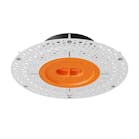LRC, NYSERDA, and NYSDOT cooperate for sustainable roadway lighting education
Troy, N.Y. — Until recently, roadway lighting technologies changed very slowly. Technologies like high pressure sodium (HPS) and other high intensity discharge (HID) lamps used in cobra head-style fixtures were state-of-the-art for decades. In response, the best practices for roadway lighting design had remained largely unchanged since the 1970s and 1980s. A growing concern for preventing light pollution in the 1990s and 2000s morphed the dropped lenses of cobra head fixtures to flat glass windows, but this did not fundamentally change lighting design methods and standards, and tried and true tools for roadway lighting design from a generation ago continued to be useful.
Fast forward to 2014, and the roadway lighting landscape is changing rapidly. Agencies responsible for designing and maintaining safe roadways have a bewildering array of options for roadway lighting design including not only HPS systems that still make up the majority of roadway illumination systems on roads, but also light emitting diode (LED) technologies, new forms of ceramic metal halide (CMH) lamps, fluorescent induction lamps, and plasma light sources. Controls for these lighting systems are making dimming and switching easier as well, so street lights don't need to burn continuously from dusk to dawn as they have for decades. Unfortunately, there has been a lack of objective information available regarding current options for sustainable roadway lighting. In collaboration with the New York State Energy Research and Development Authority (NYSERDA) and the New York State Department of Transportation (NYSDOT), the Lighting Research Center (LRC) at Rensselaer Polytechnic Institute conducted three "Sustainable Roadway Lighting" seminars across New York State for NYSDOT engineers, local municipalities, electric utilities, and lighting specifiers. Instructors John Bullough and Leora Radetsky, LRC scientists, shared the basics of roadway lighting, techniques for evaluating different lighting technologies, new ways to quantify the efficiency and effectiveness of roadway lighting, and upcoming concepts that may transform how roadway lighting is practiced. The LRC has developed a guidebook containing the seminar content, which is a useful reference tool for seminar participants and non-participants alike. Download the free guidebook at: www.nyserda.ny.gov/-/media/Files/Publications/Research/Transportation/Sustainable-Roadway-Lighting-Seminars.pdf Outdoor Lighting Institute! October 28-29, 2014 There are still a few seats left for the LRC’s Outdoor Lighting Institute, October 28-29, 2014, at the LRC in Troy, New York. The two-day, hands-on, practical course teaches engineers, lighting designers, and other professionals how to effectively design, specify, and commission energy-efficient lighting installations for a variety of outdoor sites and locations including streets and roadways, parking areas, parks, and pedestrian areas. For more details and to inquire about registering, visit: www.lrc.rpi.edu/education/outreachEducation/OutdoorInstitute.asp About the Lighting Research Center The Lighting Research Center (LRC) at Rensselaer Polytechnic Institute is the world’s leading center for lighting research and education. Established in 1988 by the New York State Energy Research and Development Authority (NYSERDA), the LRC has been pioneering research in energy and the environment, light and health, transportation lighting and safety, and solid-state lighting for more than 25 years. In 1990, the LRC became the first university research center to offer graduate degrees in lighting and today the LRC offers both a M.S. in lighting as well as a Ph.D. to educate future leaders in lighting. Internationally recognized as the preeminent source for objective information on all aspects of lighting technology and application, LRC researchers conduct independent, third-party testing of lighting products in the LRC’s state of the art photometric laboratories, the only university lighting laboratories accredited by the National Voluntary Laboratory Accreditation Program (NVLAP Lab Code: 200480-0). LRC researchers are continuously working to develop new and better ways to measure the value of light and lighting systems, such as the effect of light on human health. The LRC believes that by accurately matching the lighting technology and application to the needs of the end user, it is possible to design lighting that benefits both society and the environment. Follow the LRC on Twitter! http://www.twitter.com/LRCupdates
Contact:
Rebekah Mullaney - Lighting Research Center, Rensselaer Polytechnic Institute
+1-518-687-7118
E-mail:
Web site:
www.lrc.rpi.edu
Submit new products, case studies/projects, and other press releases at http://www.ledsmagazine.com/content/leds/en/addcontent.html and http://www.ledsmagazine.com/content/leds/en/iif/add.html.





